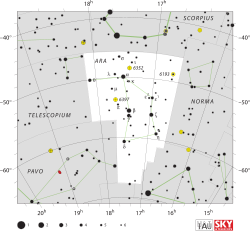| Observation data Epoch J2000 Equinox J2000 | |
|---|---|
| Constellation | Ara |
| Right ascension | 17h 35m 39.58957s[1] |
| Declination | –46° 30′ 20.4618″[1] |
| Apparent magnitude (V) | +4.575[2] |
| Characteristics | |
| Spectral type | A0 V[3] |
| U−B color index | –0.064[2] |
| B−V color index | –0.027[2] |
| Astrometry | |
| Proper motion (μ) | RA: –25.78[1] mas/yr Dec.: –38.30[1] mas/yr |
| Parallax (π) | 8.62 ± 0.26 mas[1] |
| Distance | 380 ± 10 ly (116 ± 3 pc) |
| Absolute magnitude (MV) | 1.40[4] |
| Details | |
| Luminosity (bolometric) | 26.4[4] L☉ |
| Temperature | 9,790[4] K |
| Other designations | |
| Database references | |
| SIMBAD | data |
Sigma Arae (σ Ara, σ Arae) is the Bayer designation for a star in the southern constellation of Ara. It is visible to the naked eye with an apparent visual magnitude of +4.575.[2] The distance to this star, based upon an annual parallax shift of 8.62 mas,[1] is around 380 light-years (120 parsecs).
This is an A-type main sequence star with a stellar classification of A0 V.[3] Unusually for an A-type star, X-ray emissions with a luminosity of 4.6 × 1029 erg s−1 have been detected from Sigma Arae. Normally this is explained by the presence of a lower mass orbiting companion star. However, such a scenario does not appear to hold true for this star. Instead, the signature of a surface magnetic field has been detected with a strength of roughly 128 ± 73 Gauss, indicating the source of the X-rays may be surface magnetic activity.[6]
References
- ^ a b c d e f van Leeuwen, F. (November 2007), "Validation of the new Hipparcos reduction", Astronomy and Astrophysics, 474 (2): 653–664, arXiv:0708.1752, Bibcode:2007A&A...474..653V, doi:10.1051/0004-6361:20078357, S2CID 18759600.
- ^ a b c d Cousins, A. W. J. (1973), "Revised zero points and UBV photometry of stars in the Harvard E and F regions", Memoirs of the Royal Astronomical Society, 77: 223–236, Bibcode:1973MmRAS..77..223C.
- ^ a b Houk, Nancy (1978), Michigan catalogue of two-dimensional spectral types for the HD stars, vol. 2, Ann Arbor: Dept. of Astronomy, University of Michigan, Bibcode:1978mcts.book.....H.
- ^ a b c Neff, James E.; Simon, Theodore (September 2008), "O VI Observations of the Onset of Convection Zones in Main-Sequence A Stars", The Astrophysical Journal, 685 (1): 478–488, arXiv:0805.4459, Bibcode:2008ApJ...685..478N, doi:10.1086/590423, S2CID 8607533
- ^ "* sig Ara". SIMBAD. Centre de données astronomiques de Strasbourg. Retrieved 2012-08-02.
{{cite web}}: CS1 maint: postscript (link) - ^ Schröder, C.; Hubrig, S.; Schmitt, J. H. M. M. (June 2008), "Magnetic fields in A-type stars associated with X-ray emission", Astronomy and Astrophysics, 484 (2): 479–486, Bibcode:2008A&A...484..479S, doi:10.1051/0004-6361:20078963

